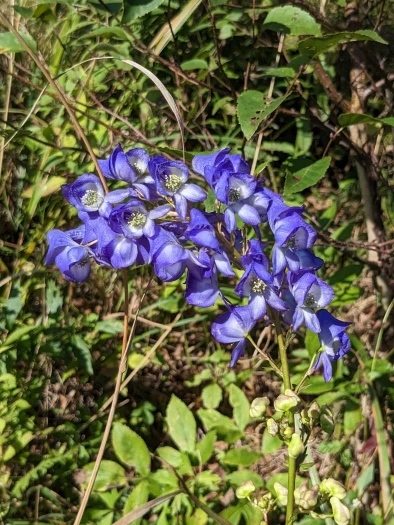Kusnezoff’s Monkshood
(Aconitum kusnezoffii)
Kusnezoff’s Monkshood (Aconitum kusnezoffii)
/
/

Repina Tatyana
CC BY 4.0
Image By:
Repina Tatyana
Recorded By:
Copyright:
CC BY 4.0
Copyright Notice:
Photo by: Repina Tatyana | License Type: CC BY 4.0 | License URL: http://creativecommons.org/licenses/by/4.0/ | Rights Holder: Repina Tatyana | Publisher: iNaturalist | Date Created: 2023-09-08T15:15:05-07:00 |






Estimated Native Range
Climate Requirements for Bochum-Hordel, Germany
| This Plant | Your Site | Plant Suitability for Your Location | ||
|---|---|---|---|---|
| • Precipitation | 8" - 79" | 36" | Aquatic | Aquatic |
| • High Temp. | 62°F - 93°F | 75°F | Your summer temperatures are normal for this plant. | Excellent |
| • Low Temp. | -52°F - 48°F | Unknown°F | Your winter temperatures are normal for this plant | Excellent |
This plant may not grow well at your location - your precipitation is too high.
Summary
Aconitum kusnezoffii, commonly known as Kusnezoff’s monkshood, is a herbaceous perennial native to the mountainous regions of East Asia, including China, Korea, and Russia. It is typically found in the understory of deciduous forests, forest margins, and alpine meadows, where it enjoys cool, moist conditions. This species can grow up to 1.5 meters tall and is characterized by its deeply divided, dark green leaves and its late summer blooms. The flowers are hooded, deep purple-blue, and highly showy, attracting pollinators such as bees and butterflies. However, all parts of the plant are highly toxic if ingested.
Kusnezoff’s monkshood is valued for its striking flowers and is used in shaded garden areas, woodland gardens, and borders. It requires consistently moist soil, partial to full shade, and good drainage to thrive. While it is a beautiful addition to the garden, its high toxicity makes it unsuitable for areas frequented by children and pets. Gardeners must handle this plant with care, wearing gloves to avoid skin contact. There are no popular cultivars of significant note, but its dramatic appearance makes it a noteworthy species on its own. Potential problems include root rot in overly wet soils and foliar diseases in humid conditions. It is not known to be invasive outside its native range, but its toxicity should be considered when planting.CC BY-SA 4.0
Kusnezoff’s monkshood is valued for its striking flowers and is used in shaded garden areas, woodland gardens, and borders. It requires consistently moist soil, partial to full shade, and good drainage to thrive. While it is a beautiful addition to the garden, its high toxicity makes it unsuitable for areas frequented by children and pets. Gardeners must handle this plant with care, wearing gloves to avoid skin contact. There are no popular cultivars of significant note, but its dramatic appearance makes it a noteworthy species on its own. Potential problems include root rot in overly wet soils and foliar diseases in humid conditions. It is not known to be invasive outside its native range, but its toxicity should be considered when planting.CC BY-SA 4.0
Plant Description
- Plant Type: Herb
- Height: 3-5 feet
- Width: 1-2 feet
- Growth Rate: Moderate
- Flower Color: Blue
- Flowering Season: Summer
- Leaf Retention: Deciduous
Growth Requirements
- Sun: Part Shade
- Water: Medium
- Drainage: Medium
Common Uses
Border Plant, Butterfly Garden, Deer Resistant
Natural Habitat
Understory of deciduous forests and alpine meadows in mountainous regions of East Asia
Other Names
Common Names: Kusnezoff’s Monkshood, Cao Wu, Monkshood
Scientific Names: Aconitum kusnezoffii, ? dissectum, Aconitum birobidshanicum, Aconitum gibbiferum, Aconitum kusnezoffii subsp. birobidshanicum, Aconitum kusnezoffii subsp. latisectum, Aconitum kusnezoffii subsp. tenuisectum, Aconitum kusnezoffii var. birobidshanicum, Aconitum kusnezoffii var. crispulum
GBIF Accepted Name: Aconitum kusnezoffii